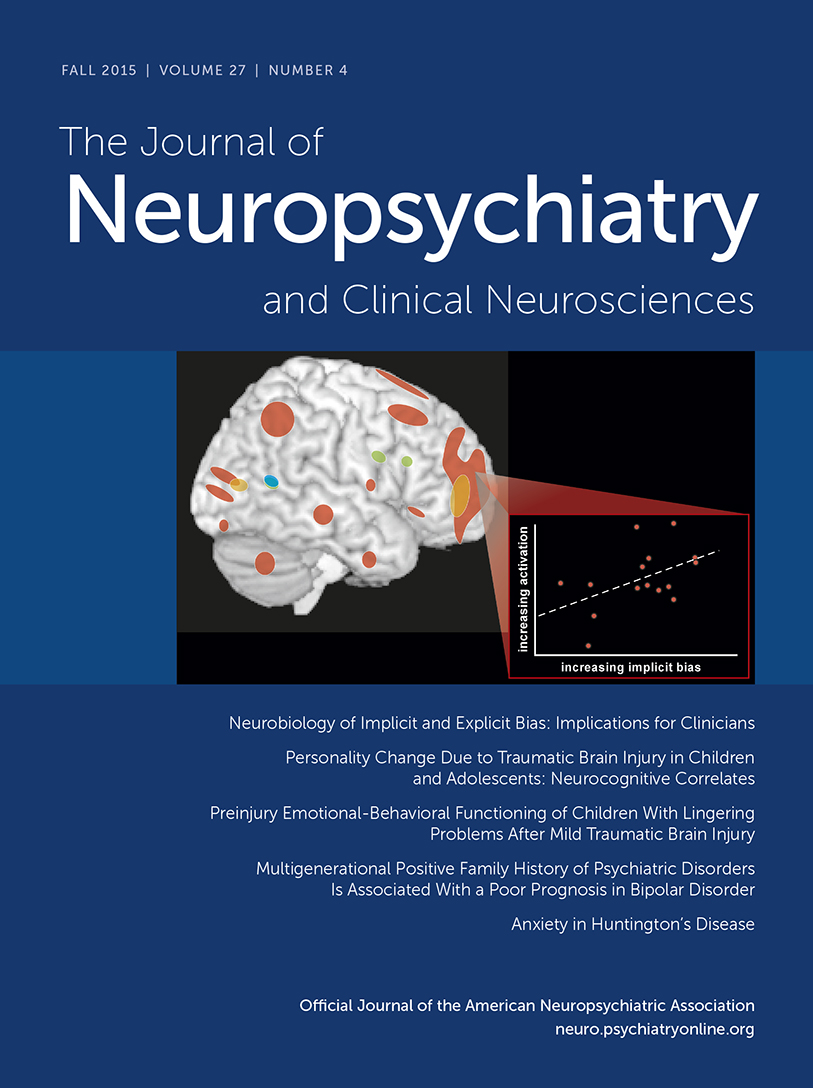Research Trends in the Neuropsychiatry Literature Since the New Millennium
Abstract
The authors examined current research trends in neuropsychiatry by analyzing original research studies published since the new millennium. A total of 14,587 articles published between 2000 and 2013 were systematically screened from 10 neuropsychiatry journals, which were selected based on impact factor ranking. Clinical studies accounted for the highest proportion of neuropsychiatry research articles published since the new millennium (N=5,097; 68.9%), followed by laboratory studies (N=1,824; 24.7%) and service evaluation, classification, and historical studies (N=474; 6.4%). This study confirms that neuropsychiatry is a quintessentially clinical discipline with a continuing focus on phenomenological aspects, possibly reflecting the centrality of clinical observations to the diagnostic process.
Neuropsychiatry is a medical discipline that can be seen as an interface between neurology, psychiatry, and psychology.1 The International Neuropsychiatric Association definition states that neuropsychiatry is “a field of scientific medicine that concerns itself with the complex relationship between human behavior and brain function, and endeavors to understand abnormal behavior and behavioral disorders on the basis of an interaction of neurobiological and psychological-social factors.”2 The theoretical framework within which neuropsychiatry clinical practice and research activity are carried out challenges the traditional assumptions of Cartesian dualism (i.e., that the brain and mind are separate domains), because the idea that the brain is inextricably linked to the concept of mind implies that psychiatric disorders can be related to brain dysfunction. During the last few decades, advances in neurosciences—ranging from neurobiology to neurogenetics and neuroimaging—resulted in important insights into the brain processes underlying specific behavioral problems and revealed important correlations between specific behavioral problems and alterations in brain processes.3,4 In recent years, there has been a surge in research activity focusing on important conditions that traditionally elicited little academic interest (e.g., functional neurological symptoms), further emphasizing the significance of neuropsychiatry as a specialty in its own right.5–7
Bibliometric analysis, a research methodology that allows for an objective evaluation of research focus and trends,8,9 has acquired increasing relevance for different reasons. First, examination of the previous literature allows for a better understanding of temporal shifts in research focus.10 This in turn provides information to researchers regarding the growth of knowledge in certain topics and its subsequent clinical effects, and this examination highlights gaps of research in potentially relevant areas of the discipline under study. A critical appraisal of these trends can assist researchers, grant providers, and policymakers in prioritizing topics that require increased attention and funding, taking into account limitations in resources.11 Bibliometric analysis can also help practicing clinicians to identify current areas of research focus and can increase public interest and awareness into the relevant medical field.12 Bibliometric analysis is increasingly being used by scientific institutions and journals as a key component of medical research.13,14
Bibliometric studies have provided useful insights into research trends across several medical disciplines, ranging from ultrasound investigations15 to obstructive sleep apnea syndrome.16 Recent studies examining the most cited works within epilepsy,17 depression,18 Parkinson’s disease,19 and Tourette’s syndrome20 have prompted a historical review of the most developed areas of research within these conditions. In addition, citation classics have also been identified in the broader field of neurosurgery.21 However, to our knowledge there are currently no studies that have examined research trends within neuropsychiatry by use of bibliometric analysis. This study aimed to examine the development of research trends in neuropsychiatry from 2000 to 2013, by using bibliometric analysis of relevant articles published in the most important neuropsychiatry journals.
Methods
In this study, we carried out the first comprehensive bibliometric analysis on the scientific literature in neuropsychiatry since the turn of the millennium. The selection of the sources for the scientific literature aimed to identify the most important journals in the field of neuropsychiatry. The 2012 edition of the Journal Citation Reports was accessed through Thomson Reuters Web of Science (formerly ISI Web of Knowledge), and the search was extended to all relevant disciplines, including behavioral sciences, clinical neurology, neuroimaging, neurosciences, psychiatry, and psychology. For each discipline, the journals were ranked according to their 2012 impact factors. A journal’s impact factor is the average number of citations received for each article published in the journal during the preceding 2 years.22 To identify all relevant neuropsychiatry journals, these lists were crosschecked with the list of neuropsychiatry journals published in TheAmerican Psychiatric Publishing Textbook of Neuropsychiatry and Behavioral Neurosciences by Yudofsky and Hales.23 This process resulted in the identification of the 10 most relevant neuropsychiatry journals according to current impact factors (range=0.5–4.9). Finally, an active researcher in the field of clinical neuropsychiatry was consulted in order to ensure that all identified journals were relevant to the field and that no relevant journal had been missed. All selected journals are international peer-reviewed journals that publish high-quality research and are indexed in major scientific databases, including PubMed. Table 1 provides a summary of the main features of the 10 neuropsychiatry journals.
| Journal | Organization | Start Year | Issues per Year | Impact Factor (2012) |
|---|---|---|---|---|
| Journal of Neurology, Neurosurgery & Psychiatry | British Medical Journal (BMJ) group | 1920 | 12 | 4.9 |
| Journal of Neuropsychiatry and Clinical Neurosciences | American Neuropsychiatric Association | 1989 | 4 | 2.4 |
| Neuropsychiatric Disease and Treatment | 2005 | 4 | 2.0 | |
| Journal of Nervous and Mental Disease | 1874 | 12 | 1.8 | |
| CNS Spectrums | 1996 | 12 | 1.7 | |
| Cognitive Neuropsychiatry | 1996 | 6 | 1.7 | |
| Behavioural Neurology | 1998 | 8 | 1.2 | |
| Cognitive and Behavioral Neurology | Society for Behavioral and Cognitive Neurology | 1988 | 4 | 1.2 |
| Acta Neuropsychiatrica | Scandinavian College of Neuropsychopharmacology | 1989 | 6 | 0.6 |
| Neuropsychiatry | 2011 | 6 | 0.5 |
TABLE 1. Neuropsychiatry Journals Used in the Bibliometric Analysis
Bibliometric research strategies were used to collect and analyze the study data. For each journal included in the analysis, each issue within each year was manually screened for the period from 2000 to 2013. In relationship to standard formats of journals and for the scope of bibliometric analysis, articles were categorized under the following types: original studies, short reports/brief communications, reviews, case reports, letters to the editor, editorials/commentaries, book reviews, and other articles (e.g., conference proceedings, errata, etc.).17–21 The article types of relevance for this study were original studies and short reports/brief communications, because these were the main indicators of research trends at the time of publication.
Original studies and short reports/brief communications were further classified into various categories and domains. The three main article categories were as follows: 1) clinical studies, 2) laboratory studies, and 3) service evaluation, classification, and historical studies. The clinical studies category consisted of the following six domains: clinical evaluation, epidemiological, pharmacological treatment, surgical treatment, behavioral and physical treatment, and other clinical. The laboratory studies category included the following seven domains: neuroimaging, neurophysiological, genetic, neurobiological, neuropathological, animal, and other laboratory studies. These categories and domains were derived from two previous articles that examined citation classics in epilepsy24 and Tourette’s syndrome,20 which are two quintessentially neuropsychiatric disorders that provide useful models for bibliometric studies in this field.25–28 A pilot analysis was conducted on six issues of the Journal of Neurology, Neurosurgery & Psychiatry (from January to June 2012) to determine whether the articles would successfully fit into the categories and domains. The pilot study revealed that the classification system was adequate to capture all relevant articles and that no further categories or domains were required for classification of articles.
Statistically significant trends in the proportions of studies in each article category and domain between 2000 and 2013 were assessed using the Mantel-Haenszel linear-by-linear association test (p values < 0.01 were considered statistically significant). All analyses were performed using IBM SPSS statistics 21 software.
Results
A total of 14,587 articles published between 2000 and 2013 were manually screened. These included 7,395 relevant articles (5,605 original studies and 1,790 short reports/brief communications). A total of 7,192 articles (1,340 reviews, 790 case studies, 1,833 letters to the editor, 1,703 editorials, 1,244 book reviews, and 282 other articles) were excluded from this analysis. The largest number of relevant articles were published in the Journal of Neurology, Neurosurgery & Psychiatry (N=3,373) and the Journal of Nervous and Mental Disease (N=1,814), followed by the Journal of Neuropsychiatry and Clinical Neurosciences (N=609), Neuropsychiatric Disease and Treatment (N=395), Cognitive and Behavioral Neurology (N=342), Acta Neuropsychiatrica (N=249), Cognitive Neuropsychiatry (N=236), Behavioural Neurology (N=206), CNS Spectrums (N=161), and Neuropsychiatry (N=10).
In regard to categories, the relevant articles included 5,096 clinical studies (68.9%), 1,825 laboratory studies (24.7%), and 474 service evaluation, classification, and historical studies (6.4%). Of the article domains, clinical evaluation was the most represented, accounting for 41.8% of all articles published between 2000 and 2013. This was followed by epidemiological (11.3%) and neuroimaging (10.3%) studies, as shown in Figure 1.
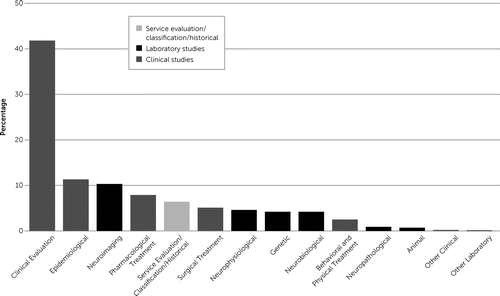
FIGURE 1. Proportion of Articles Published Between 2000 and 2013 in Each Category Domain
Table 2 shows the total number of relevant articles by study category/domain, with breakdown figures for each journal. There was heterogeneity in the article categories and domains published by each journal, with the Journal of Neurology, Neurosurgery & Psychiatry publishing proportionately more laboratory studies (N=1,284; 70.4% of all articles of this category published in the neuropsychiatry journals during the analysis period) and the Journal of Nervous and Mental Disease publishing proportionately more service evaluation, classification, and historical studies (N=230; 48.5%).
| Study Category/Domain | J Neurol Neurosurg Psychiatry | J Neuropsychiatry Clin Neurosci | Neuropsychiatr Dis Treat | J Nerv Ment Dis | CNS Spectr | Cogn Neuropsychiatry | Behav Neurol | Cogn Behav Neurol | Acta Neuropsychiatr | Neuropsychiatry | Total |
|---|---|---|---|---|---|---|---|---|---|---|---|
| Clinical studies (total) | 2,016 (39.6) | 406 (8.0) | 289 (5.7) | 1,549 (30.4) | 129 (2.5) | 200 (3.9) | 135 (2.6) | 238 (4.7) | 127 (2.5) | 8 (0.2) | 5,097 |
| Clinical evaluation | 1,061 (34.3) | 262 (8.5) | 119 (3.8) | 1,052 (34.0) | 49 (1.6) | 190 (6.1) | 104 (3.4) | 193 (6.2) | 60 (1.9) | 3 (0.1) | 3,093 |
| Epidemiological | 349 (41.7) | 31 (3.7) | 26 (3.1) | 343 (41.0) | 23 (2.8) | 5 (0.6) | 10 (1.2) | 11 (1.3) | 35 (4.2) | 3 (0.4) | 836 |
| Pharmacological treatment | 254 (43.3) | 80 (13.7) | 119 (20.3) | 29 (4.9) | 53 (9.0) | 3 (0.5) | 6 (1.0) | 17 (2.9) | 24 (4.1) | 1 (0.2) | 586 |
| Surgical treatment | 306 (81.0) | 33 (8.7) | 11 (2.9) | 5 (1.3) | 1 (0.3) | 0 (0.0) | 7 (1.9) | 14 (3.7) | 1 (0.3) | 0 (0.0) | 378 |
| Behavioral and physical treatment | 42 (22.3) | 0 (0.0) | 14 (7.4) | 108 (57.4) | 3 (1.6) | 2 (1.1) | 8 (4.3) | 3 (1.6) | 7 (3.7) | 1 (0.5) | 188 |
| Other clinical | 4 (26.7) | 0 (0.0) | 0 (0.0) | 11 (73.3) | 0 (0.0) | 0 (0.0) | 0 (0.0) | 0 (0.0) | 0 (0.0) | 0 (0.0) | 15 |
| Laboratory studies (total) | 1,284 (70.4) | 158 (8.7) | 76 (4.2) | 35 (1.9) | 19 (1.0) | 24 (1.3) | 51 (2.8) | 70 (3.8) | 107 (5.9) | 0 (0.0) | 1,824 |
| Neuroimaging | 545 (71.3) | 88 (11.5) | 15 (2.0) | 12 (1.6) | 10 (1.3) | 5 (0.7) | 30 (3.9) | 39 (5.1) | 20 (2.6) | 0 (0.0) | 764 |
| Neurophysiological | 211 (62.4) | 33 (9.8) | 11 (3.3) | 14 (4.1) | 1 (0.3) | 17 (5.0) | 18 (5.3) | 24 (7.1) | 9 (2.7) | 0 (0.0) | 338 |
| Genetic | 227 (78.0) | 16 (5.5) | 12 (4.1) | 5 (1.7) | 5 (1.7) | 2 (0.7) | 0 (0.0) | 2 (0.7) | 22 (7.6) | 0 (0.0) | 291 |
| Neurobiological | 233 (75.6) | 19 (6.2) | 21 (6.8) | 4 (1.3) | 3 (1.0) | 0 (0.0) | 2 (0.6) | 3 (1.0) | 23 (7.5) | 0 (0.0) | 308 |
| Neuropathological | 62 (92.5) | 2 (3.0) | 0 (0.0) | 0 (0.0) | 0 (0.0) | 0 (0.0) | 0 (0.0) | 1 (1.5) | 2 (3.0) | 0 (0.0) | 67 |
| Animal | 1 (2.0) | 0 (0.0) | 17 (33.3) | 0 (0.0) | 0 (0.0) | 0 (0.0) | 1 (2.0) | 1 (2.0) | 31 (60.8) | 0 (0.0) | 51 |
| Other laboratory studies | 5 (100.0) | 0 (0.0) | 0 (0.0) | 0 (0.0) | 0 (0.0) | 0 (0.0) | 0 (0.0) | 0 (0.0) | 0 (0.0) | 0 (0.0) | 5 |
| Service evaluation/classification/historical | 73 (15.4) | 45 (9.5) | 30 (6.3) | 230 (48.5) | 13 (2.7) | 12 (2.5) | 20 (4.2) | 34 (7.2) | 15 (3.2) | 2 (0.4) | 474 |
TABLE 2. Total Numbers of Relevant Articles by Study Category/Domain, With Breakdown Figures for Each Journala
Figure 2 shows the proportion of articles published year by year in each category. The proportions of clinical studies and service evaluation, classification, and historical studies showed an overall increase between 2000 and 2013, whereas the proportion of laboratory studies decreased during the same period.
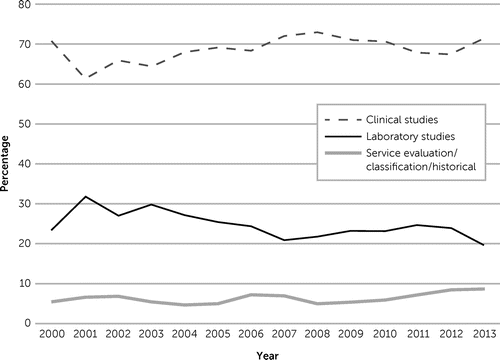
FIGURE 2. Year-by-Year Proportion of Articles Published in Each Category Between 2000 and 2013
Figure 3 and Figure 4 show the proportion of articles published year by year in the clinical and laboratory domains, respectively. Within the clinical domains, the clinical evaluation and surgical treatment domains decreased in proportion between 2000 and 2013, whereas the epidemiological, pharmacological treatment, and behavioral and physical treatment domains increased in proportion during the same period. The other clinical studies domain included only 15 articles (0.2%) focusing on complementary and alternative therapies, without significant variations in year-by-year proportion.
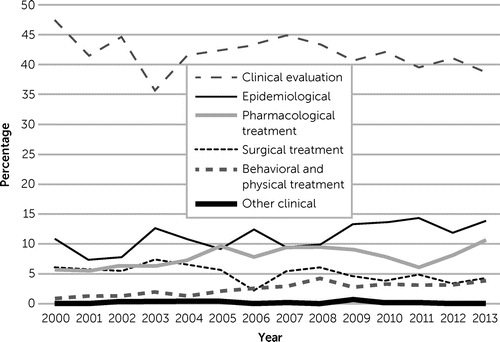
FIGURE 3. Year-by-Year Proportion of Articles Published in Clinical Domains Between 2000 and 2013
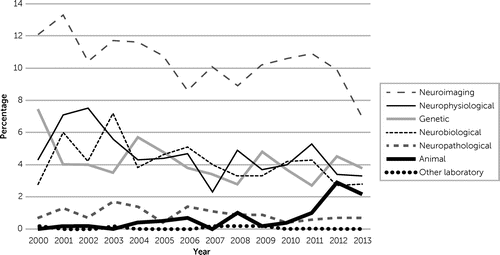
FIGURE 4. Year-by-Year Proportion of Articles Published in Laboratory Domains Between 2000 and 2013
Within the laboratory domains, the neuroimaging, neurophysiological, genetic, neurobiological, and neuropathological domains decreased in proportion between 2000 and 2013, whereas the animal domain increased during this period. The other laboratory studies domain included only five articles (0.1%) focusing on portable devices and monitors, without significant variations in year-by-year proportion.
Because there was an overlap of 95% confidence intervals when proportions were compared year by year for each article category and domain, the Mantel-Haenszel linear-by-linear association test was used to determine whether the observed trends were statistically significant. Table 3 shows the results of the linear-by-linear association analysis for each of the categories and domains. The observed changes in publication proportions were statistically significant for the clinical study category and the epidemiological, pharmacological treatment, behavioral and physical treatment, and animal study domains (increase) as well as for the laboratory study category and the surgical treatment, neuroimaging, and neurophysiological study domains (decrease).
| Article Category/Domain | Linear-by-Linear Association Value | p Value |
|---|---|---|
| Clinical studies (total) | 7.666 | 0.01 |
| Clinical evaluation | 2.859 | 0.09 |
| Epidemiological | 15.072 | 0.001 |
| Pharmacological treatment | 9.556 | 0.002 |
| Surgical treatment | 8.225 | 0.004 |
| Behavioral and physical treatment | 21.265 | 0.001 |
| Other clinical | 0.275 | 0.60 |
| Laboratory studies (total) | 18.322 | 0.001 |
| Neuroimaging | 9.195 | 0.002 |
| Neurophysiological | 9.522 | 0.002 |
| Genetic | 5.293 | 0.02 |
| Neurobiological | 6.183 | 0.01 |
| Neuropathological | 2.394 | 0.12 |
| Animal | 35.55 | 0.001 |
| Other laboratory studies | 0.518 | 0.47 |
| Service evaluation/classification/historical | 5.266 | 0.02 |
TABLE 3. Mantel-Haenszel Linear-by-Linear Association Value for Each Article Category and Domain
Discussion
In this study, we used bibliometric methods to identify, categorize, and analyze original neuropsychiatry research published in the most relevant international peer-reviewed neuropsychiatry journals since the new millennium. Our results showed that clinical studies were the most represented research category in neuropsychiatry, showing an overall increase in proportion between 2000 and 2013.
The high proportion of clinical studies identified by this study confirms that neuropsychiatry is a quintessentially clinical discipline with ever-increasing focus on phenomenological aspects of disease presentation and progression. Yudofsky and Hales29 described the field of neuropsychiatry as a “grey zone,” which primarily concerns itself with the assessment and treatment of patients falling between the specialties of neurology and psychiatry. As developments occur in neuroscience research, the territory and depth of knowledge within the fields of neurology and psychiatry have continued to expand. With this advancement, the mind-brain dichotomy has become less tangible, thus emphasizing the importance of research into the clinical diagnosis and treatment of an increasing subset of disorders that cannot be effectively managed in either neurology or psychiatry alone.2 A further reason for the emphasis of clinical studies within neuropsychiatry may be the diagnostic importance of clinical criteria focusing on sensorimotor (neurological), behavioral (psychiatric), and cognitive (neuropsychological) symptoms.29 Laboratory studies, such as neuroimaging and neurophysiological studies, hold clinical value in assisting clinicians in the differential diagnosis, but these studies are not currently used as diagnostic criteria per se across neuropsychiatric disorders. This diagnostic approach may contribute to explain the enduring difference in the proportion between clinical and laboratory studies in neuropsychiatry research since the new millennium. Although laboratory techniques are often research oriented, their clinical relevance may become more apparent and reflect in higher proportions of laboratory studies in the future.2 Service evaluation, classification, and historical studies have focused primarily on the validity of diagnostic classification and rating scales within neuropsychiatry. This article category is traditionally less represented in scientific journals, because it might be perceived by researchers as less important compared with research focusing on clinical evaluation, therapeutic management, and neuroscience advancement. These considerations are in line with the unsurprising finding of its lower representation within the neuropsychiatry field.
Within the clinical studies category, clinical evaluation was the most highly represented domain. This suggests that knowledge derived from research findings in clinical phenomenology is still central to the definition and understanding of neuropsychiatric presentations. The epidemiological domain was the second highest in representation, which may reflect the perceived importance of filling our knowledge gaps in the actual prevalence and etiological aspects of neuropsychiatric conditions. The pharmacological, surgical, and behavioral and physical treatment domains were less well represented, possibly suggesting unmet needs in the development of new treatment options. This is recognized as an expanding field, and more research is needed to improve the therapeutic potential for most neuropsychiatric disorders.30
Neuroimaging was the most highly represented domain within the laboratory studies category, reflecting the recent advances in multimodal imaging techniques within the past decades to allow for neuroanatomical, neurochemical, and neurometabolic investigations.31,32 This was followed by the neurophysiological domain, which highlights the ongoing research interest in electroclinical correlates across a range of disorders such as the epilepsies and encephalopathies.33 The genetic and neurobiological domains were moderately represented, and they reflected an emphasis on gene-environment studies as well as recent discoveries in biomarkers and endophenotypes through proteomic, metabolomic, and lipidomic approaches within neurobiological studies.4,34
The proportion of clinical studies showed a significant increase between 2000 and 2013, which can be attributed to the significant increase in epidemiological, pharmacological, and behavioral and treatment domains during the same period. Despite considerable advancements in laboratory techniques during the last decade, which are largely driven by neuroimaging, the proportion of laboratory studies significantly decreased between 2000 and 2013. Within this category, there were significant decreases in the neuroimaging and neurophysiological domains. This may be attributable to the focus on clinical studies and progression within treatment domains, which may have overshadowed more basic neuroscience research within neuropsychiatry because of their clinical importance. However, it is important to note that the animal domain showed a significant increase in this period, possibly owing to the emergence of newly developed animal models during the last few years.
This study has limitations. First, the selection of 10 journals inevitably results in a constraint of the full inclusion of neuropsychiatry research. Although a considerable number of original research articles were analyzed, this does not represent the entirety of original research published between 2000 and 2013. Second, relevant and influential neuropsychiatry studies may have been published within other neuropsychiatry journals as well as within neurology, psychiatry, psychology, or general medical journals. For example, several important articles on neuropsychiatry topics were not included in our analysis if they were published in journals characterized by a wider scope and a higher impact factor. Furthermore, the time parameters used in this study account for the first 14 years of research activity since the new millennium; articles published beyond this period have not been examined and could have given a different perspective to the research trends in the neuropsychiatric literature. The data collected in this study were analyzed by descriptive statistics. Although this approach provides quantitative evidence of overall research trends within the neuropsychiatric literature, the causes for the observed differences in research trends (e.g., topic neglect, perceived relevance, funding gaps, and editorial policies) remain open to different interpretations.
The results from this study confirm that neuropsychiatry is a quintessentially clinical discipline with an ever-increasing focus on phenomenological aspects, reflecting the centrality of clinical observations to the diagnostic process.35,36 These findings also suggest areas for future research. Additional data could be collected from other relevant journals, both within the 2000–2013 period as well as in preceding years, to validate the significance of the trends observed within the timeframe of this study. Bibliometric analysis could also be undertaken in the neurology, psychiatry, and psychology literature to determine whether research trends vary significantly between these overlapping fields compared with neuropsychiatry and whether a substantial proportion of relevant neuropsychiatry research is published within neurology, psychiatry, or psychology journals. Moreover, qualitative studies may help to evaluate the research trends identified in this study. Interviews with active researchers and experienced clinicians working in neuropsychiatry departments can provide useful information and evidence as to whether the current research focus is appropriate and expected or whether changes in direction are necessary for the further development of neuropsychiatry as an ever-evolving discipline.30
1 : The evolving discipline and services of neuropsychiatry in the United Kingdom. Acta Neuropsychiatr 2012; 24:191–198Crossref, Medline, Google Scholar
2 : Whither neuropsychiatry? J Neuropsychiatry Clin Neurosci 2005; 17:140–144Link, Google Scholar
3 : Neuropsychiatry: where are we and where do we go from here? Mens Sana Monogr 2013; 11:4–15Crossref, Medline, Google Scholar
4 : General overview: biomarkers in neuroscience research. Int Rev Neurobiol 2011; 101:1–17Crossref, Medline, Google Scholar
5 : Functional symptoms in neurology: questions and answers. J Neurol Neurosurg Psychiatry 2005; 76:307–314Crossref, Medline, Google Scholar
6 : Functional (conversion) neurological symptoms: research since the millennium. J Neurol Neurosurg Psychiatry 2012; 83:842–850Crossref, Medline, Google Scholar
7 Sachdev P; Curriculum Committee of the International Neuropsychiatric Association: Core curriculum in neuropsychiatry of the International Neuropsychiatric Association, in Neuropsychiatric Disorders. Edited by Miyoshi K, Morimura Y, Maeda K. Tokyo, Springer, 2010, pp 317–346Google Scholar
8 : A bibliometric and citation analysis of stroke-related research in Taiwan. Scientometrics 2007; 72:201–212Crossref, Google Scholar
9 : Bibliometric indicators of university research performance in Flanders. J Am Soc Inf Sci 1998; 49:59–67Crossref, Google Scholar
10 : Citation indexing for studying science. Nature 1970; 227:669–671Crossref, Medline, Google Scholar
11 : Publication of European Union research on infectious diseases (1991-2001): a bibliometric evaluation. Eur J Clin Microbiol Infect Dis 2004; 23:180–184Crossref, Medline, Google Scholar
12 : Trends in research in two general psychiatric journals in 1969-1990: research on research. Am J Psychiatry 1993; 150:135–142Crossref, Medline, Google Scholar
13 : A scientometric analysis of research output from Indian Institute of Technology, Kharagpur. Scientometrics 2002; 53:165–168Crossref, Google Scholar
14 : The portrait of a journal as reflected in its publications, references and citations: Inorganica Chimica Acta, 1990–1994. Inorg Chim Acta 1996; 253:111–118Crossref, Google Scholar
15 : Bibliometric analysis of ultrasound research trends over the period of 1991 to 2006. J Clin Ultrasound 2009; 37:319–323Crossref, Medline, Google Scholar
16 : Bibliometric analysis of obstructive sleep apnea research trends. J Chin Med Assoc 2009; 72:117–123Crossref, Medline, Google Scholar
17 : The most cited works in epilepsy: Trends in the “Citation Classics”. Epilepsia 2012; 53:765–770Crossref, Medline, Google Scholar
18 : The most cited works in major depression: the ‘Citation classics’. J Affect Disord 2011; 134:39–44Crossref, Medline, Google Scholar
19 : The most cited works in Parkinson’s disease. Mov Disord 2011; 26:380–390Crossref, Medline, Google Scholar
20 : The most cited works in Tourette syndrome. J Child Neurol 2012; 27:1250–1259Crossref, Medline, Google Scholar
21 : Highly cited works in neurosurgery. Part II: the citation classics. J Neurosurg 2010; 112:233–246Crossref, Medline, Google Scholar
22 : Impact factors: use and abuse. Medicina (B Aires) 2003; 63:347–354Medline, Google Scholar
23 : The American Psychiatric Publishing Textbook of Neuropsychiatry and Behavioral Neurosciences. Arlington, VA, American Psychiatric Publishing, Inc., 2007Google Scholar
24 : Citation classics in epilepsy. Rev Health Care 2013; 4:11–28Google Scholar
25 : The classification of neuropsychiatric disorders in epilepsy: a proposal by the ILAE Commission on Psychobiology of Epilepsy. Epilepsy Behav 2007; 10:349–353Crossref, Medline, Google Scholar
26 Trimble MR, Schmitz B (eds): The Neuropsychiatry of Epilepsy. Cambridge, UK, Cambridge University Press, 2011Crossref, Google Scholar
27 : The psychopathological spectrum of Gilles de la Tourette syndrome. Neurosci Biobehav Rev 2013; 37:1008–1015Crossref, Medline, Google Scholar
28 : Tourette’s syndrome. BMJ 2013; 347:f4964Crossref, Medline, Google Scholar
29 : Neuropsychiatry and the future of psychiatry and neurology. Am J Psychiatry 2002; 159:1261–1264Crossref, Medline, Google Scholar
30 Wysong P: Neuropsychiatry: past, present, and future descriptions: an expert interview with Jonathan Silver, MD. www.medscape.com/viewarticle/702996#2Google Scholar
31 : Magnetic resonance spectroscopy and its applications in psychiatry. Aust N Z J Psychiatry 2002; 36:31–43Crossref, Medline, Google Scholar
32 : 2-Deoxy-fluorglucose-positron emission tomography imaging of the brain: current clinical applications with emphasis on the dementias. Semin Nucl Med 2004; 34:300–312Crossref, Medline, Google Scholar
33 : The role of EEG in epilepsy: a critical review. Epilepsy Behav 2009; 15:22–33Crossref, Medline, Google Scholar
34 : Gene-environment interactions in psychiatry: joining forces with neuroscience. Nat Rev Neurosci 2006; 7:583–590Crossref, Medline, Google Scholar
35 : Assessment and measurement in neuropsychiatry: a conceptual history. Semin Clin Neuropsychiatry 2002; 7:3–10Crossref, Medline, Google Scholar
36 : Clinical neurology: why this still matters in the 21st century. J Neurol Neurosurg Psychiatry 2015; 86:229–233Crossref, Medline, Google Scholar


